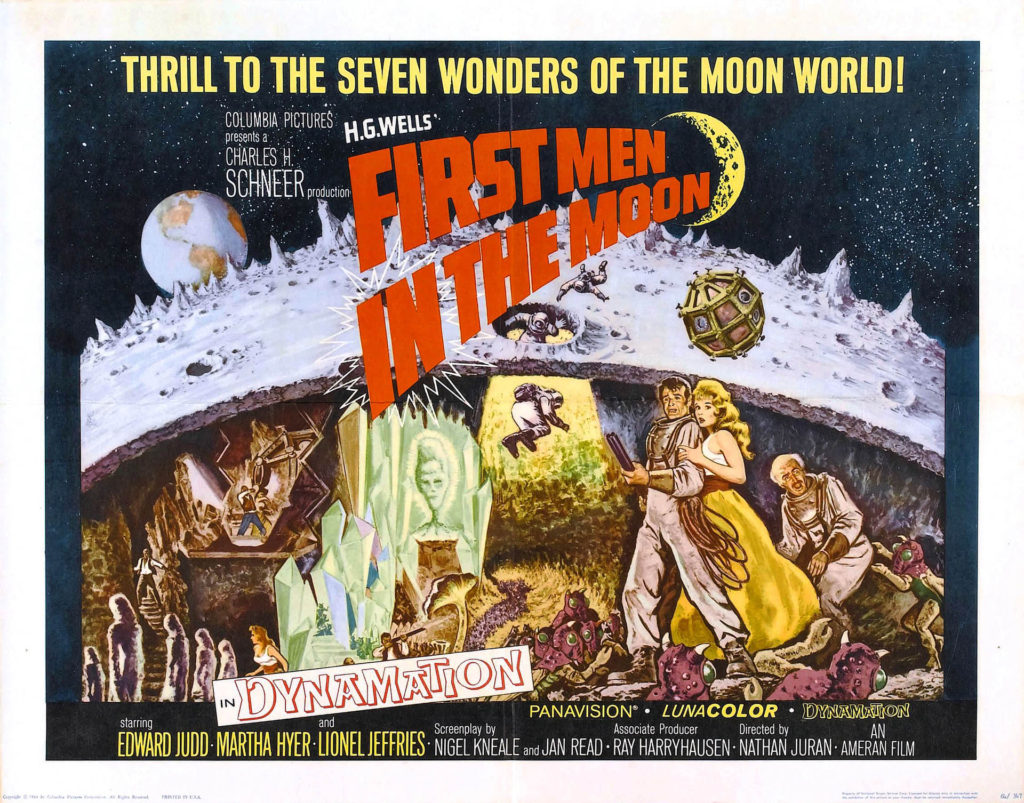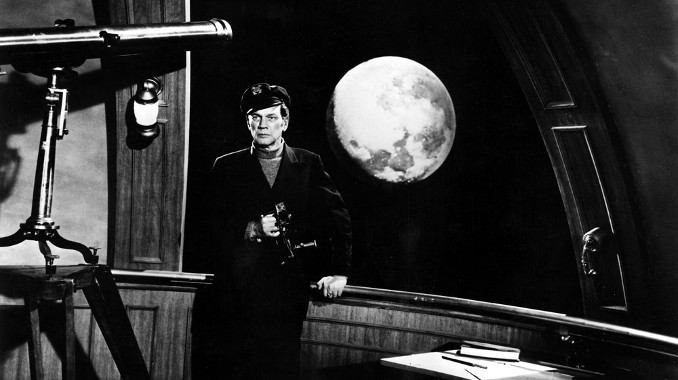Fifty years ago today, humanity first set foot on the moon. TCM has been celebrating with a month-long sci-fi festival, beginning with George Méliès’ A Trip to the Moon: one of the first science-fiction films ever made and over a century later, still one of the best. Alongside the robots, metropolises and things from another world were From the Earth to the Moon and First Men in the Moon, two lunar adventures that were new to me.
Based on Jules Verne’s 1865 novel of the same name, From the Earth to the Moon was part of a wave of Verne adaptations that crashed onto audiences after Walt Disney’s 20,000 Leagues Under the Sea. The late fifties and early sixties saw the release of Around the World in 80 Days, Journey to the Center of the Earth, Master of the World, Mysterious Island, In Search of the Castaways and Five Weeks in a Balloon—all adaptations of varying fidelity and quality.
Robert Blees and James Leicester’s screenplay for From the Earth to the Moon follows the rough outlines of Verne’s novel. In 1868, weapons manufacturer Victor Barbicane (Joseph Cotten) calls a meeting of the International Armament Club to announce his newest invention: ‘Power X’, the most powerful explosive the world has ever seen. To demonstrate its potential, he plans to launch a projectile at the Moon, which has the misfortune of being the nearest completely uninhabited wasteland. Barbicane is the soul of confidence, the sort of man who names his estate ‘Victory’ and can ask for millions from his fellow club members with a cheerful grin. His greatest rival is Stuyvesant Nicholl (George Sanders), a metallurgist who believes Barbicane is a danger to the human race. “I must disgrace him or kill him before he destroys the world,” Nicholl says. The man is a self-righteous maniac driven by religious fervour but at least he’s straightforward. Like Cotten, Sanders does what is asked of him, nothing more; with lines like that it’s hard to blame him.
Nicholl challenges Barbicane to a duel and when the latter refuses, changes tack and bets him $100,000 that ‘Power X’ can’t destroy a sample of the new plate armour Nicholl has developed. Barbicane’s explosive obliterates not just Nicholl’s metal, but the cliff it was hanging from, consuming everything in a ball of flame that also offers some relief from the film’s dreary palette of blues, greys and various shades of brown.
From the Earth to the Moon is suspiciously reluctant to leave orbit. It takes nearly 45 minutes for Barbicane to bring up the idea of space flight and when the rocket finally blasts off the audience sees why—the film has run out of plot.
I watched From the Earth for Cotten, Sanders and Verne, none of whom are well served by a film that, metaphorically, never gets off the ground. The editing is choppy, the characters are thin and though the rocket’s wood-panelled observatory looks decent, the special effects are an embarrassment: rarely has a more static object strained to give the illusion of flight. Director Byron Haskin knew how to make a sci-fi film—he had directed The War of the Worlds five years before—and the mess on screen isn’t entirely his fault. From the Earth to the Moon was one of the last films RKO made before it slid into oblivion and the studio kept slashing the film’s budget, with the deepest cuts being made to the special effects. Still, if all you have is a film in which characters talk endlessly, the least you can do is make their conversations interesting.

First Men in the Moon has a higher action to talking ratio and is all the happier for it. Based on The First Men in the Moon, a 1901 novel by H.G. Wells, the film was written by Nigel Kneale (of Quatermass fame) and Jan Read, who insert a clever framing device: an international team of astronauts makes the first lunar landing, only to discover a weathered Union Flag and a note claiming the Moon in the name of Queen Victoria. Incredulous, one astronaut holds the flag up to compare it with the one on his British colleague’s suit; the aggrieved Englishman protests, “Well, I didn’t do it!” Back on Earth, a group from the UN Space Agency investigates, eventually discovering Arnold Bedford (Edward Judd), an old man with a story to tell.
The rest of the film unfolds in flashback. Bedford is an unsuccessful playwright who has retired to the English countryside to hide from his creditors and write a new play. The cottage he rents happens to be next door to the home of Joseph Cavor (Lionel Jeffries), a textbook mad scientist whose enthusiasm is matched only by his absent-mindedness; his laboratory has a lovely collection of mysterious liquids and bubbling flasks. Cavor has invented a substance he calls ‘Cavorite’, which defies gravity, and which he demonstrates to Bedford by coating a chair with it—a chair Bedford insists on sitting on. Naturally, Bedford ends up pinned to the ceiling. (The film has an unfortunate predilection for slapstick.) While Cavor tries to get him down, all Bedford can talk about are the financial possibilities—Victorian cupidity at its finest. Cavor coaxes Bedford into joining him on an expedition to the Moon in a spaceship covered in Cavorite—and must find room for one more when Bedford’s fiancée Kate Callender (Martha Hyer) accidentally joins them.
Directed by Nathan Juran, First Men in the Moon is much more entertaining than From the Earth to the Moon, partly because it doesn’t take itself too seriously. This is a film that features ‘moon cows’: giant caterpillar-like creatures animated by Ray Harryhausen. The production design is eye-catching, particularly the lunar landscape, grey crags against an inky sky, and Cavor’s space capsule, an endearingly home-made contraption decked out in rope ladders, upholstered walls and brass fittings. Interestingly, Harryhausen based the modern expedition’s vehicles on blueprints loaned from NASA.
Five years after First Men in the Moon was released, we finally made it there, forever changing the way we saw our closest neighbour and shifting the cinematic frontier to Mars. First Men in the Moon isn’t perfect and From the Earth to the Moon certainly isn’t either. Yet both films are symbols of a collective yearning: a dream that asked how great our imagination, how high the Moon.

I have heard of “First Men In The Moon” but not “From The Earth To The Moon”. From what I know, there are diverse opinions on the former. Some advance that the special effects are spectacular and others say that is not the case.